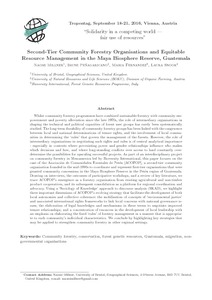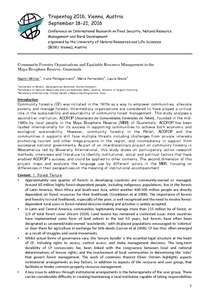silvicultura comunitária
AGROVOC URI:
Restoring lives and landscapes: How a partnership between local communities and the state is saving forest and improving livelihoods in Guinea
Retablir les viet et les paysages: comment une association entre les collectivites locales et l'etat s'avere sauver les forets et ameliore les moyens d'existence en Guinee
Rights to forests and carbon under REDD+ initiatives in Latin America
Rights to large areas of forest have been granted to communities and indigenous peoples in Latin America, offering these groups an opportunity to participate in REDD+ initiatives. However, tenure is not always secure, and security of tenure alone is insufficient to guarantee positive outcomes for both forests and livelihoods. The question of carbon tenure rights has only just begun to be addressed, and even less attention has been given to liabilities. REDD+ initiatives provide an opportunity to consolidate indigenous territories but present a risk to those without secure land rights.
Secondary forests of the Himalaya with emphasis on the north-eastern hill region of India
Secondary forests form a major component of the forest types in the Central Himalayan region and in the north eastern hills of India. Deforestation in these areas is largely due to external pressures of timber extraction for industrial use. When large scale deforestation from outside the region is superimposed upon the demands of the local communities for food, fodder and fuelwood, the previously balanced use of forest resources, including the management of swidden fallow secondary forests, becomes impaired.
Second-tier community forestry organisations and equitable resource management in the Maya Biosphere Reserve, Guatemala
Whilst community forestry programmes have combined sustainable forestry with community empowerment and poverty alleviation since the late 1970s, the role of intermediary organisations in shaping the technical and political capacities of forest user groups has rarely been systematically studied. The long-term durability of community forestry groups has been linked with the congruence between local and national determinations of tenure rights, and the involvement of local communities in determining the ‘rules' that govern the management of the forests.
Second-tier community forestry organisations and equitable resource management in the Maya Biosphere Reserve, Guatemala
Community forestry (CF) was initiated in the 1970s as a way to empower communities, alleviate poverty and manage forests. Intermediary organisations are considered to have played a critical role in the sustainability and equitability of community forest management. This study analyses a second-tier institution, ACOFOP [Asociación de Comunidades Forestales de Petén], founded in the mid-1990s by local people in the Maya Biosphere Reserve [MBR] of Guatemala. ACOFOP has been
Self-governance and forest resources
Forest resources share attributes with many other resource systems that make difficult their governance and management in a sustainable, efficient and equitable manner. Destruction or degradation of forest resources is most likely to occur in open-access forests where those involved, or external authorities, have not established effective governance. Conventional theories applied to forest resources presumed that forest users themselves were incapable of organizing to overcome the temptations to overharvest.
Scoring and analysis guide for assessing human well-being
The Scoring and Analysis Guide for Assessing Human Well-Being is designed to supplement The BAG and The Grab Bag. It provides a scoring method that can be used with the two manuals, to come to a decision about particular criteria and indicators in particular forest and human settings. Following the section on scoring is a section on analysis. It begins very simply, leading the user through the steps of making a spreadsheet, and concluding with more complex statistical analyses that may be desirable in some circumstances.
Secondary forests in swidden agriculture inthe highlands of Thailand
Swidden farming is the main agent of conversion of primary forests to secondary forests in the highlands of mainland Southeast Asia, but there is a deterioration and decline of the practice with land use intensification. The population growth in northern Thailand has forced lowland farmers practising permanent wet rice cultivation to turn to short rotation swidden in the foot hill zone. Highland swidden agriculturists are adopting more intensive forms of swidden or are shifting to permanent farming.
Siapa yang perlu dipertimbangkan? menilai kesejahteraan manusia dalam pengelolaan hutan lestari
Who counts most? Assessing human well being in sustainable forest management presents a tool, 'the Who Counts Matrix', for differentiating 'forest actors', or people whose well-being and forest management are intimately intertwined, from other stakeholders. The authors argue for focusing formal attention on forest actors in efforts to develop sustainable forest management.



